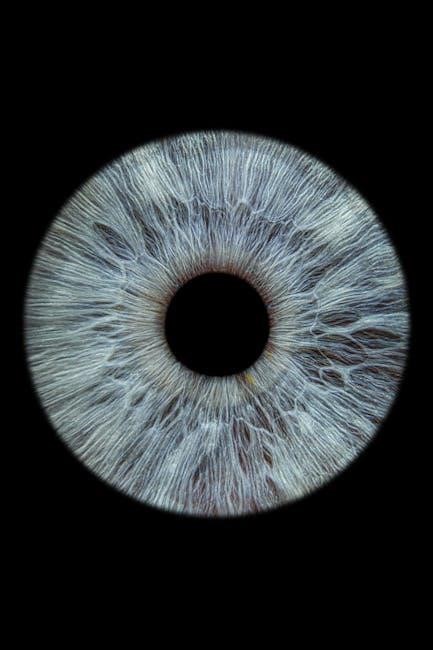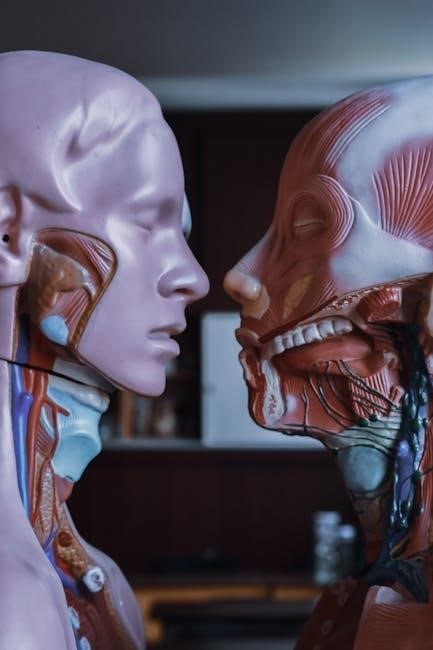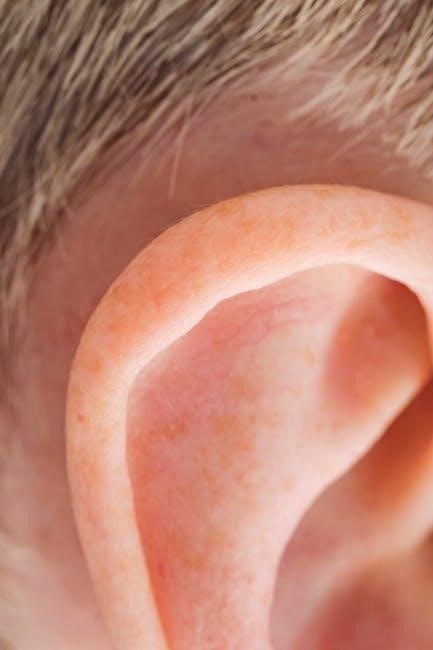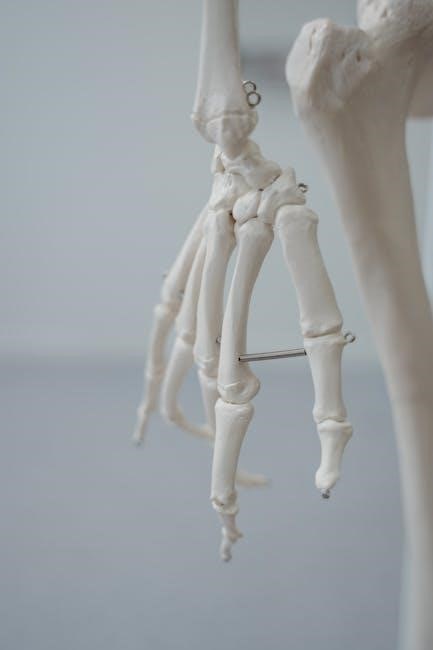Anatomy and physiology questions and answers PDFs provide comprehensive resources for students, covering topics like body systems, cells, and biological molecules. These materials are ideal for exam preparation, offering multiple-choice questions, detailed explanations, and practice exercises to enhance understanding and retention of key concepts.
1.1 Importance of Multiple Choice Questions (MCQs) in Anatomy and Physiology
Multiple Choice Questions (MCQs) are a cornerstone of anatomy and physiology education, offering a structured way to assess knowledge and understanding. They are particularly useful for exam preparation, as they simulate real-world testing environments and help students gauge their readiness. MCQs cover a wide range of topics, from basic concepts like anatomical terminology to complex processes such as cellular physiology. By practicing with MCQs, students can identify knowledge gaps and reinforce their understanding of key concepts. Additionally, MCQs often include detailed explanations, providing valuable learning opportunities. Regular practice with MCQs enhances critical thinking and time management skills, essential for success in professional licensing exams like those for nursing and pharmacy technicians.
1.2 Overview of Anatomy and Physiology as a Field of Study
Anatomy and physiology are fundamental sciences that explore the structure and function of living organisms, particularly the human body. Anatomy focuses on the physical organization of body parts, such as organs, tissues, and cells, while physiology examines how these components function and interact. Together, they provide a comprehensive understanding of how the body operates under normal and pathological conditions. This field is essential for healthcare professionals, as it forms the basis of diagnosis, treatment, and prevention of diseases; Studying anatomy and physiology requires a strong foundation in biological sciences, including chemistry, biology, and biochemistry. It is a dynamic field, continuously evolving with advances in medical research and technology. Understanding these concepts is vital for careers in nursing, medicine, and allied health professions, as they enable professionals to make informed clinical decisions and provide effective patient care. Mastery of anatomy and physiology is also critical for developing new treatments and therapies, making it a cornerstone of healthcare education and practice. By combining theoretical knowledge with practical applications, anatomy and physiology equips students with the skills needed to address complex health challenges and improve patient outcomes. This dual focus on structure and function ensures a holistic approach to understanding the human body, preparing learners for a wide range of professional roles in the medical field.
1.3 Benefits of Using PDF Resources for Exam Preparation
Using PDF resources for anatomy and physiology exam preparation offers numerous benefits. PDFs are easily accessible and portable, allowing students to study anywhere, anytime, without internet connectivity. They provide a structured format with clear headings, diagrams, and bullet points, making complex information easier to digest. PDFs also enable quick searching for specific topics, saving time during revision. Additionally, they are environmentally friendly, reducing the need for printed materials. Many PDF resources are free or low-cost, making them an affordable study option. They can be annotated and highlighted, facilitating personalized learning. PDFs are also shareable among peers, promoting collaborative study. Overall, PDF resources enhance efficiency and convenience, making them a valuable tool for successful exam preparation.

Major Organ Systems in the Human Body
The human body comprises 11 major organ systems, each with unique functions. These include the respiratory, circulatory, nervous, digestive, endocrine, and urinary systems, working harmoniously to sustain life and maintain overall health.
2.1 Respiratory System: Structure and Function
The respiratory system is essential for exchanging oxygen and carbon dioxide through the process of breathing. It includes the nose, pharynx, larynx, trachea, bronchi, and lungs. The nasal cavity filters, warms, and humidifies air, while the lungs contain alveoli where gas exchange occurs. The diaphragm and intercostal muscles facilitate inhalation and exhalation. This system is vital for delivering oxygen to the bloodstream and removing carbon dioxide, supporting cellular respiration and energy production. Understanding its structure and function is critical for addressing anatomy and physiology questions, especially in clinical contexts like respiratory disorders.
2.2 Circulatory System: Heart and Blood Vessels
The circulatory system, also known as the cardiovascular system, is responsible for transporting oxygen, nutrients, and hormones throughout the body while removing waste products. It consists of the heart, arteries, veins, and capillaries. The heart, a muscular organ, pumps blood through two circuits: pulmonary (lungs) and systemic (body). Arteries carry oxygen-rich blood away from the heart, while veins return oxygen-depleted blood. Capillaries facilitate exchange between blood and tissues. This system is vital for maintaining cellular function and overall health. Understanding its structure and function is key for answering anatomy and physiology questions, particularly those related to blood flow, pressure, and common disorders like hypertension or arrhythmias.
2.3 Nervous System: Brain, Spinal Cord, and Nerves
The nervous system is a complex network that controls and coordinates body functions, enabling communication between cells, tissues, and organs. It comprises the central nervous system (CNS), including the brain and spinal cord, and the peripheral nervous system (PNS), consisting of nerves. The brain processes information, regulates emotions, and controls voluntary actions, while the spinal cord acts as a relay center for nerve signals. Nerves transmit electrical and chemical signals, facilitating responses to stimuli. This system is essential for sensory perception, movement, and maintaining homeostasis. Understanding its components and functions is crucial for answering anatomy and physiology questions, particularly those related to reflexes, neural pathways, and sensory-motor integration.

Cell Structure and Biological Molecules
Understanding cell structure and biological molecules is fundamental for anatomy and physiology. Cells are basic life units, with organelles performing specific functions. Biological molecules like proteins, carbohydrates, lipids, and nucleic acids are essential for cellular processes and overall bodily functions, forming the foundation for advanced topics like metabolism and homeostasis.
3.1 Components of a Cell and Their Functions
A cell is composed of several key components, each with specific roles. The cell membrane, or plasma membrane, regulates the movement of materials in and out, maintaining cellular integrity. Cytoplasm, the jelly-like substance inside the membrane, is where many metabolic processes occur. The nucleus contains genetic material, directing cell activities. Mitochondria generate energy through ATP production, while ribosomes synthesize proteins essential for cellular function. Lysosomes break down waste and foreign substances, and the Golgi apparatus modifies and transports molecules. Each component works together to ensure proper cellular operation, making them fundamental to understanding anatomy and physiology;
3.2 Types of Biological Molecules and Their Roles
Biological molecules are essential for life, functioning as building blocks and regulators of bodily processes. Carbohydrates, such as glucose, serve as primary energy sources. Proteins, including enzymes and hormones, perform diverse roles like catalyzing reactions and signaling. Lipids, like cholesterol and triglycerides, form cell membranes and aid in energy storage. Nucleic acids, DNA and RNA, store and transmit genetic information. Additionally, enzymes accelerate biochemical reactions, while hormones regulate various physiological activities. Understanding these molecules is crucial for grasping how cells and systems operate, making them a key focus in anatomy and physiology studies. Their roles are vital for maintaining life and health.
3.3 Importance of Homeostasis in Cellular Physiology
Homeostasis is crucial for maintaining the stable internal environment necessary for proper cellular functions. It ensures optimal conditions for enzyme activity, pH balance, temperature regulation, and ion concentrations, all essential for cellular processes like metabolism, DNA replication, and protein synthesis. Without homeostasis, cells cannot efficiently carry out these vital functions, leading to potential dysfunction or disease. Cells employ feedback mechanisms to maintain homeostasis, ensuring the stability required for survival. Understanding homeostasis is fundamental in anatomy and physiology, as it underpins the functioning of all bodily systems. Its regulation is vital for overall health and cellular integrity, making it a cornerstone in physiological studies.

Terminology in Anatomy and Physiology
Understanding anatomy and physiology terminology is crucial for effective communication and comprehension in both educational and professional environments, ensuring accurate diagnoses and treatments.
4.1 Understanding Anatomical Positions and Planes
Anatomical positions and planes provide a standardized framework for describing the human body’s structure and orientation. The standard anatomical position is upright, facing forward, with arms at the sides and palms facing forward. This reference point helps in locating body structures accurately. The body is divided into three main planes: sagittal (vertical), frontal (coronal, vertical), and transverse (horizontal). The sagittal plane divides the body into left and right, while the frontal plane separates anterior and posterior portions. The transverse plane divides the body into upper and lower sections. Understanding these planes is essential for medical imaging, dissection, and precise communication in anatomy and physiology.
4.2 Prefixes, Suffixes, and Root Words in Medical Terminology
Mastering prefixes, suffixes, and root words is crucial for understanding medical terminology in anatomy and physiology. Prefixes, such as “hypo-” (under) or “hyper-” (above), describe conditions or locations. Suffixes like “-itis” (inflammation) or “-ectomy” (removal) indicate processes or procedures. Root words, often derived from Greek or Latin, form the core of medical terms, such as “cardio-” for heart or “neuro-” for nerves. Combining these elements allows for precise communication in healthcare. For example, “hypothyroidism” combines “hypo-” (under), “thyroid-” (thyroid gland), and “-ism” (condition), meaning an underactive thyroid gland. This knowledge aids in decoding unfamiliar terms and enhances proficiency in anatomy and physiology exams.
4.3 Key Terms Related to Physiology and Their Definitions
Understanding key physiological terms is essential for grasping fundamental concepts in anatomy and physiology. Terms like homeostasis (maintaining internal balance) and metabolism (chemical reactions for energy) are central to physiological processes. Stimulus and response describe how organisms react to environmental changes. Acid-base balance refers to maintaining pH levels in bodily fluids. Osmosis and diffusion explain how substances move across cell membranes. Neurotransmitters are chemicals enabling nerve communication, while hormones regulate various bodily functions. These terms form the foundation of physiological studies and are frequently tested in anatomy and physiology exams. Mastering them enhances understanding and performance in related subjects.

Practice Questions on Body Systems
This section provides practice questions covering major body systems, such as skeletal, muscular, and digestive. It helps reinforce understanding and prepares for exams effectively.
5.1 Skeletal System: Bones and Joints
The skeletal system comprises 206 bones, providing structural support and protection for organs. Questions in this section cover bone classifications, such as long, short, flat, irregular, and sesamoid bones. Topics include bone functions like movement, blood cell production, and mineral storage. Joint types, including synovial, cartilaginous, and fibrous joints, are explored, along with their roles in mobility. Ligaments and their importance in joint stability are also addressed. Multiple-choice questions test understanding of bone fractures, ossification, and common skeletal disorders like osteoporosis. True/false questions reinforce knowledge of bone marrow and the axial vs. appendicular skeleton. This section is ideal for nursing and physiology students preparing for exams like NCLEX-RN.
5.2 Muscular System: Types of Muscles and Their Functions
The muscular system consists of three types of muscles: skeletal, smooth, and cardiac. Skeletal muscles are voluntary, attaching to bones to facilitate movement and maintain posture. Smooth muscles are involuntary, found in organs like the digestive tract, enabling functions like peristalsis; Cardiac muscle is specialized for the heart, ensuring rhythmic contractions. Questions in this section cover muscle structure, including sarcomeres and myofibrils, as well as contraction mechanisms like the sliding filament theory. Topics also include muscle fibers, motor units, and the role of the nervous system in muscle control. True/false and multiple-choice questions assess understanding of muscle physiology and disorders like muscular dystrophy.
5.3 Digestive System: Organs and Processes
The digestive system comprises organs that break down food into nutrients for absorption. Key organs include the mouth, esophagus, stomach, small intestine, pancreas, liver, gallbladder, and large intestine. Processes involve mechanical digestion, such as chewing and churning, and chemical digestion via enzymes like amylase, lipase, and trypsin. The stomach acids and bile facilitate nutrient breakdown. Absorption primarily occurs in the small intestine, with water absorption in the large intestine. Common questions cover the roles of digestive enzymes, the structure of the gastrointestinal tract, and disorders like gastroesophageal reflux disease (GERD). Multiple-choice and true/false questions test understanding of digestion processes and organ functions.

Blood and Lymphatic System
The blood and lymphatic system transport oxygen, nutrients, and waste products. Blood consists of plasma, red blood cells, white blood cells, and platelets, maintaining immunity and circulation. The lymphatic system supports immune function by filtering pathogens and aiding in fluid balance. Key topics include blood cell formation, lymph node structure, and the role of the spleen. Multiple-choice questions often focus on blood types, anemia, and lymphatic disorders, ensuring a thorough understanding of these interconnected systems.
6.1 Composition of Blood and Its Functions
Blood is a vital connective tissue composed of plasma and formed elements. Plasma, making up about 55% of blood, is mostly water, containing proteins, nutrients, hormones, gases, waste products, and ions. The formed elements include red blood cells (RBCs), which transport oxygen and carbon dioxide; white blood cells (WBCs), essential for immune responses; and platelets, crucial for clotting. Blood functions include transporting oxygen and nutrients to cells, removing waste, regulating pH and temperature, and maintaining homeostasis. It also plays a key role in immune defense and clotting to prevent excessive bleeding. Understanding blood composition is fundamental for diagnosing disorders like anemia and leukemia.
6.2 Blood Disorders and Their Physiological Impact
Blood disorders can significantly disrupt normal physiological functions. Anemia, characterized by low red blood cell count or hemoglobin, impairs oxygen delivery to tissues, leading to fatigue and weakness. Leukemia, a cancer of white blood cells, disrupts immune function and increases infection risk. Hemophilia, a clotting disorder, causes prolonged bleeding due to deficient platelets or clotting factors. Sickle cell disease results in misshapen red blood cells, obstructing blood flow and causing pain crises. These conditions highlight the importance of blood in maintaining oxygen transport, immune defense, and clotting. Early diagnosis and treatment are crucial to manage symptoms and prevent complications, emphasizing the need for comprehensive understanding.

6.3 Lymphatic System: Structure and Role in Immunity
The lymphatic system consists of lymph nodes, the spleen, lymphoid organs, and lymphatic vessels, playing a crucial role in immunity. It filters lymph, a fluid rich in nutrients and waste, returning it to the bloodstream. Lymph nodes act as hubs for immune cells, such as lymphocytes, which recognize and destroy pathogens. The spleen removes pathogens and old red blood cells from the blood. This system also aids in detoxification and supports the circulatory system. Its immune function is vital for defending against infections and diseases. Understanding its structure and role is essential for anatomy and physiology exams, as it highlights the body’s defense mechanisms and overall health maintenance.

Hormones and the Endocrine System
The endocrine system produces hormones regulating metabolism, growth, reproduction, and more. Key glands include the pituitary, thyroid, pancreas, adrenal, and gonadal glands, essential for bodily functions.
7.1 Major Endocrine Glands and Their Hormones
The endocrine system comprises several key glands that produce hormones essential for various bodily functions. The pituitary gland, often referred to as the “master gland,” regulates other endocrine glands and produces hormones like ACTH and ADH. The thyroid gland releases thyroxine, which controls metabolism. The pancreas produces insulin and glucagon to regulate blood sugar levels. The adrenal glands release adrenaline (epinephrine) and aldosterone, influencing stress response and electrolyte balance. The gonadal glands (ovaries and testes) produce sex hormones like estrogen, progesterone, and testosterone. These hormones maintain homeostasis, growth, and reproductive processes, making them vital for overall health.
7.2 Role of Hormones in Maintaining Homeostasis
Hormones play a critical role in maintaining homeostasis by regulating various physiological processes. They act as chemical messengers, controlling functions like metabolism, growth, and electrolyte balance. For instance, insulin and glucagon regulate blood sugar levels, while thyroid hormones influence metabolic rate. Aldosterone helps maintain sodium and potassium levels, ensuring proper fluid balance. Hormones also respond to stress, with cortisol aiding in energy mobilization. Their precise regulation ensures the body operates within a narrow, healthy range. Imbalances can disrupt homeostasis, leading to conditions like diabetes or thyroid disorders. Understanding hormone function is vital for diagnosing and treating such conditions, emphasizing their importance in overall health and physiology.
7.3 Common Disorders of the Endocrine System
The endocrine system is susceptible to various disorders that disrupt hormone production and balance. Diabetes mellitus, caused by insulin deficiency or resistance, is a prevalent condition affecting blood sugar regulation. Thyroid disorders, such as hyperthyroidism (excess thyroid hormone) and hypothyroidism (deficiency), impact metabolism. Adrenal gland issues, like Cushing’s syndrome (excess cortisol) or Addison’s disease (insufficient cortisol and aldosterone), also occur. Growth hormone imbalances can lead to gigantism or acromegaly in adults. Additionally, conditions like hypopituitarism (reduced pituitary hormone production) and hyperparathyroidism (excess parathyroid hormone) further highlight the complexity of endocrine system disorders. These conditions underscore the importance of proper hormonal regulation for overall health and homeostasis.

Exam Preparation and Study Tips
Effective study strategies are crucial for success in anatomy and physiology exams. This section provides tips on time management, practice exams, and staying organized for better results.
8.1 Strategies for Solving Multiple Choice Questions
Mastering multiple-choice questions (MCQs) in anatomy and physiology requires strategic approaches. Start by skimming through all questions to identify familiar topics. Use the elimination technique to remove obviously incorrect options, increasing the chances of selecting the right answer. Pay attention to question stems and keywords, as they often hint at the correct response. For complex questions, break down the information and relate it to known concepts. Time management is critical; allocate a set time per question to avoid delays. Review your answers at the end to ensure accuracy. Practice regularly with sample MCQs from anatomy and physiology PDF resources to enhance your problem-solving skills and confidence.
8.2 Effective Use of Anatomy and Physiology PDF Resources
Anatomy and physiology PDF resources are invaluable for exam preparation due to their portability and accessibility. Students can easily download and carry these files on devices, allowing for flexible study sessions. PDFs often include detailed diagrams, charts, and practice questions, which are essential for visual learners. Highlighting and note-taking within PDFs can enhance retention of complex concepts. Additionally, these resources frequently contain summaries of key topics, making them ideal for quick reviews. Many PDFs also include practice exams, enabling students to test their knowledge under timed conditions. By organizing these resources systematically, learners can access information efficiently, ensuring comprehensive preparation for anatomy and physiology exams.
8.3 Time Management for Exam Preparation
Effective time management is crucial for success in anatomy and physiology exams. Create a structured study schedule, allocating specific time slots to each topic based on difficulty and importance. Prioritize challenging areas, such as complex systems or processes, to ensure thorough understanding. Use techniques like the Pomodoro Technique to maintain focus during study sessions. Regular breaks help prevent burnout and improve retention. Set specific goals for each study session to stay on track. Incorporate practice tests with time limits to simulate exam conditions. Avoid procrastination by breaking tasks into manageable chunks. Stick to your schedule consistently, allowing flexibility for unexpected challenges. By mastering time management, you can optimize your preparation and achieve better exam performance.

Nursing and Pharmacy Technician Exams
Nursing and pharmacy technician exams require a strong grasp of anatomy and physiology. PDF resources provide targeted practice questions, focusing on key concepts like body systems and physiological processes.
9.1 Anatomy and Physiology Questions for Nursing Students
Anatomy and physiology questions are essential for nursing students, as they form the foundation of patient care. These questions help students understand the structure and function of the human body, enabling them to identify health deviations and intervene effectively. Nursing exams often include multiple-choice questions (MCQs) that test knowledge of body systems, such as the respiratory, circulatory, and nervous systems. Topics like the structure of cells, types of tissues, and the functions of major organs are frequently covered. Additionally, case-based questions assess clinical application, such as understanding how physiological changes impact nursing interventions. Regular practice with Anatomy and Physiology questions ensures nursing students are well-prepared for licensing exams and real-world scenarios.
9.2 Pharmacy Technician Exam Questions on Anatomy and Physiology
Pharmacy technician exams often include anatomy and physiology questions to assess understanding of drug mechanisms and patient care. These questions focus on how drugs interact with body systems, such as the digestive system for absorption or the kidneys for excretion. Topics include blood pressure regulation, nervous system function, and muscle structure, as these relate to medication effects. Disease states, like diabetes or hypertension, are also covered to evaluate how physiological changes impact drug therapy. Additionally, questions may address the lymphatic system’s role in immunity and how it influences drug delivery. Practice with anatomy and physiology PDF resources is crucial for mastering these concepts and excelling in pharmacy technician exams.
9.3 Tips for Scoring High in Professional Licensing Exams
To excel in professional licensing exams, focus on mastering anatomy and physiology concepts thoroughly. Prioritize understanding over rote memorization, as this enhances problem-solving skills. Utilize high-quality PDF resources for structured study materials and practice questions. Regularly test yourself with timed practice exams to improve speed and accuracy. Develop a study schedule that allocates equal time to all body systems, ensuring no gaps in knowledge. Review and analyze mistakes to avoid repeating them. Stay healthy and well-rested to maintain peak cognitive performance during exams. Finally, remain calm and confident, as mental clarity is key to making informed decisions under pressure. Consistent effort and strategic preparation are essential for success.
Mastering anatomy and physiology requires consistent practice and understanding. Utilizing PDF resources effectively enhances exam preparation and reinforces key concepts for long-term success in medical fields.
10.1 The Role of Practice Exams in Mastering Anatomy and Physiology
Practice exams play a crucial role in mastering anatomy and physiology by simulating real-test conditions, helping students assess their knowledge and identify gaps. They allow learners to familiarize themselves with question formats and time management strategies. Regular practice exams enhance retention of complex concepts and reduce exam anxiety. By reviewing answers, students can clarify doubts and reinforce understanding. Additionally, practice exams provide a structured approach to revision, ensuring comprehensive coverage of topics. They are particularly valuable for identifying weak areas, enabling focused study. Consistent use of practice exams builds confidence and improves problem-solving skills, essential for success in anatomy and physiology assessments.
10.2 Continuous Learning and Staying Updated in the Field
Continuous learning is essential for mastering anatomy and physiology, as the field regularly evolves with new discoveries. Staying updated ensures professionals and students remain competent and informed. Subscribing to scientific journals, attending seminars, and participating in workshops can provide cutting-edge knowledge. Utilizing updated anatomy and physiology questions and answers PDF resources helps reinforce concepts and keeps study materials relevant. Engaging with online forums and educational platforms also fosters collaboration and shared learning. Regular review of textbooks and digital resources ensures familiarity with the latest terminology and advancements. By committing to lifelong learning, individuals can maintain proficiency and excel in their careers or academic pursuits.
10.3 Importance of Understanding Concepts Over Rote Learning
Mastering anatomy and physiology requires a deep understanding of concepts rather than mere rote learning. Rote learning focuses on memorization without comprehension, which can lead to poor retention and application in practical scenarios. In contrast, conceptual understanding enables students to connect ideas, apply knowledge to new situations, and think critically. This approach is especially vital for complex subjects like anatomy and physiology, where relationships between structures and functions are key. By grasping underlying principles, learners can better analyze questions, identify patterns, and solve problems effectively. This method also fosters long-term retention and prepares individuals for real-world applications in healthcare and scientific fields.
